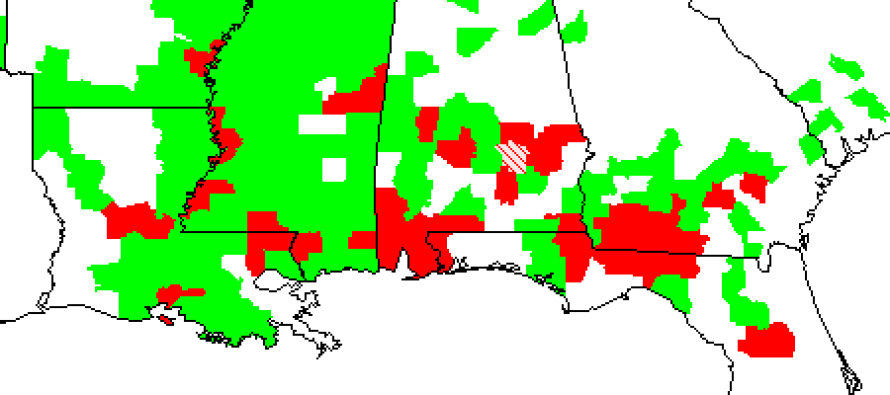Soybean Foliar Disease Update: August 21, 2012


Frogeye leaf spot. The most mature lesions are the ones with the grey center. In some cases, the center of the lesion will drop out of the lesion.
Frogeye leaf spot
Prior to 2012 I struggled to find much frogeye in MS. However, given the environment this season in addition to the susceptible varieties that we have planted throughout much of MS it is no surprise that we have a tremendous amount of frogeye leaf spot present in our soybean crop. Samples have been submitted to the University of Illinois for strobilurin resistance screening. To date, 5 samples have been submitted and aside from one of the samples not sporulating the other 4 samples were negative for strobilurin-resistant isolates. At this point that is great news. However, isolates that were recently submitted from AR have been determined to be strobilurin-resistant (http://www.arkansas-crops.com/2012/08/16/strobilurin-resistant-frogeye-leaf-spot-confirmed-in-arkansas/). If you have a field where you have continuous soybean that has been sprayed with a strobilurin fungicide, either for several continuous years or just this season, and you think you’ve had a reduction in the ability of the fungicide to reduce the observable disease symptoms please call (662-402-9995). Based on the number of years that we have applied strobilurin fungicides to soybean in MS I remain surprised (but pleasantly nonetheless) that we haven’t had a report of strobilurin fungicides failing to manage frogeye. Over the next few weeks I will collect as many leaf samples as I can get a hold of and submit those to be tested. If any change occurs the information will be disseminated here on the blog.
Soybean rust
To date soybean rust has been identified in 11 counties (10 on soybean, 1 on kudzu). The most recent observations (8/21/12) were in Lowndes and Noxubee counties on soybean and Winston County on kudzu. Plants at each of the locations that have been determined to be infected by the fungus still have actively sporulating pustules present; however, the disease is present at what can be considered to be low levels. Soybean rust generally requires several weeks to produce enough inoculum to result in a yield reduction. In addition, we continue to scout for the presence of soybean rust and have not been able to find the disease in counties adjacent to counties with infected soybean plants in the Delta (e.g. Sharkey, Washington). At this point low levels of the disease suggest spore showers occurred over the fields where infection has been observed and not over a large area. The likelihood of finding additional soybean rust increases the later we go into the season since in the recent past the disease has been considered to be more of a late-season disease. With the change in environment we’ve experienced over the past 14 days it is likely that additional counties will be turned red over the next week to 10 days. But, the low levels of soybean rust aren’t a threat to the majority of the soybean crop.
Cercospora blight (late-season Cercospora)
Observationally speaking, over the past two seasons the incidence and severity of Cercospora blight have increased in MS soybean fields. The fungus (Cercospora kikuchii) that causes Cercospora blight is responsible for producing leaves with a thick, leathery, purplish appearance, as well as dark spots on the pods, petioles, and main stem. In severe situations, such as some fields observed last year (see: https://www.mississippi-crops.com/2011/09/17/cercospora-blight-of-soybean-the-cause-of-premature-leaf-browning-and-defoliation/), the disease can lead to premature defoliation. Even though the disease is common, plant pathologists don’t have a good feel for the overall yield loss attributed to the disease nor management practices (as a whole strategy, not just a fungicide application) that might reduce the observable symptoms. The general practice of applying a fungicide at the R3/R4 timing likely provides some prevention of the disease. However, applying a fungicide when observable symptoms of the disease appear will not provide much curative ability. As opposed to some of the other foliar diseases of soybean, the appearance of Cercospora blight doesn’t necessarily suggest that a fungicide application is warranted. In addition to the foliar leaf symptoms of the disease, the fungus also produces purple seed stain. However, a correlation between foliar symptoms on the leaf and purple seed stain at harvest has never been made.





Let me tell You a sad story ! There are no comments yet, but You can be first one to comment this article.
Write a comment